The post Queen Elizabeth’s Wartime Chocolate Biscuit Cake! appeared first on Miss Windsor's Delectables.
]]>Hello, darlings!
If you failed to spot the queenly clue in the title of my recipe, then I must tell you that I recreated this splendidly simple, yet rather indulgent wartime dish purely for the delectation of Queen Elizabeth II! After all, it is Her Majesty’s most favourite afternoon teatime treat, or anytime treat as my research revealed.
And following the incredibly sad news of the one and only Forces’ Sweetheart who passed away at the grand ol’ age of 103 on the 18th June 2020, I hereby dedicate this recipe to the magnificent DAME VERA LYNN.
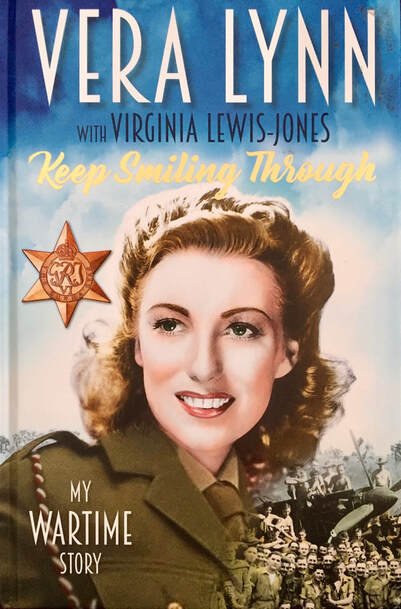
I dare say, that Her Majesty Queen Elizabeth II has been a fan of this scrumptious cake since her childhood; throughout the wartime years; and well into her monarchical era. Therefore, I deem my recreation of Irene Veal’s Chocolate Biscuit Cake rather fitting, which I gladly stumbled upon in Irene’s extraordinary contribution to the arena of wartime cookery – Recipes of the 1940’s.

The illustrious Irene Veal wrote a short, yet a rather sweet introduction for Chocolate Biscuit Cake; beautifully curtailed, with just a handful of words that sums up and describes the relevance and duty of Her Majesty’s most favoured cake.
This rather luxurious recipe must be reserved for high days and holidays during the war. Afterwards, it can perhaps become more general!
May I draw your attention to reserved for high days’– well, although this means “a religious festival”, in Miss Windsor’s book, Trooping the Colour is most definitely classed as a “high day” – I do hope you agree.
To recreate this wartime culinary marvel, it simply requires eggs, sugar, chocolate powder, butter, vanilla essence, and some plain yet delicately sweetened biscuits – the British staple of Rich Tea (will suffice!).
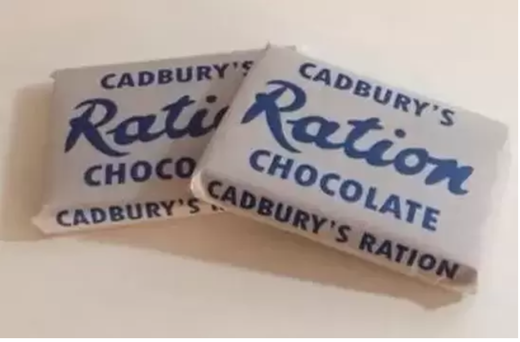
PHOTO CREDIT – CLICK HERE
Now I must divulge, Irene’s wartime version of the Queen’s favourite cake surprisingly resembles a chocolate type of Tiramisu – it’s jaw-dropping delicious, served with a scant drop of Baileys Irish Cream Liqueur. Nevertheless, next time I give it a bash, one shall reduce the number of eggs, which may assist the biscuits to remain a little crunchier.
Darlings, unfortunately, the option to slather a luxurious layer of melted chocolate over your decadent creation fit for a Queen would’ve been quite a rarity during the British wartime years, especially from July 1942 when sweets and chocolate were rationed.

But hey ho, things are a trifle different during modern-day Great Britain, so one may slather on as much melted chocolate as you wish – after all, Trooping the Colour is indeed a high day!
Legend has it, well according to the Former Chef to The British Royal Family, Darren McGrady, who informed Today (.com) on April 4th 2017, “It’s her favourite cake that she eats until it’s gone!”……..If there is anything left when she has it at Buckingham Palace, it then goes to Windsor Castle so she can finish it there.” According to my resource, Chef McGrady often travelled by train from London to Windsor Castle balancing Her Majesty’s half-eaten Chocolate Biscuit Cake on his knee – bravo, Darren!

According to one’s thorough research, Queen Elizabeth’s darling grandchild – the Duke of Cambridge (Prince William) – is also rather partial to a slice or two of his grandmother’s treasured teatime treat. He developed a liking for it so much, that it was served as the groom’s cake at his wedding to Catherine Middleton.
Darlings I do hope you enjoy whipping up Queen Elizabeth’s Wartime Chocolate Biscuit Cake – it’s so easy and so perfect for those chocoholics of the incredibly ardent and incurable kind!
Now Miss Windsor’s off to enjoy a sup or two of the Queen’s favourite tipple – gin and dubonnet.
GOD SAVE THE QUEEN (don’t forget to curtsey or bow)
Miss Windsor x
ALL PHOTOGRAPHY BY MISS WINDSOR

Queen Elizabeth’s Wartime Chocolate Biscuit Cake
Equipment
- 1 & 1/2 pint (30 US fl oz.) pudding basin
- Cling film
Ingredients
Cake
- 3 eggs
- A drop of vanilla essence
- 6 tablespoons of caster sugar
- 4 & 1/2 tablespoons of cocoa powder
- 150g (just under 3/4 cup) of butter
- Approx. 20 plain, but slightly sweetened biscuits (rich tea will do)
Chocolate Frosting
- 1 large bar of chocolate
- A dollop of butter
Garnish
- 1 plain, but slightly sweetened biscuit!
Instructions
- Beat together the eggs, sugar, and a drop of vanilla essence until pale and creamy.
- Stir in the chocolate powder and melted butter.
- Well grease your pudding basin and line with cling film (with a slight overhang) – a little tip I picked up from my culinary amour – Mrs Simkins!
- Pour into the basin a small amount of the mixture and scatter with broken biscuits. Repeat until all of the mixture and biscuits have been used up.
- Cover with a plate and refrigerate for 3 hours.
- Melt a large bar of chocolate in a saucepan over some simmering water and add a dollop of butter when melted. Stir well.
- Remove your creation gently from the basin – use a palette knife to loosen it from the sides and turnout onto a serving vessel fit for a Queen.
- Slather with melted chocolate and place a biscuit on the top before serving. Tidy up around the edges of the cake with a damp cloth.
- Serve to your guests with a scant drop of Bailey's Irish Cream Liqueur.
The post Queen Elizabeth’s Wartime Chocolate Biscuit Cake! appeared first on Miss Windsor's Delectables.
]]>The post Miss Windsor’s Pink & Spicy Gooseberry Raspberry Fool! appeared first on Miss Windsor's Delectables.
]]>Hello, darlings!
Food for thought: have you ever wondered about the origins of the illustrious Gooseberry Fool?
Well, maybe it was first served to King George III of England at a lavish dinner party? Or could it be an invention of the overindulgent Victorians? Or possibly, this dish first graced the likes of a medieval banqueting table? Indeed, a farrago of possibilities, which Miss Windsor investigated thoroughly, and, delineates her findings right here………

Eager to revive the quintessentially British (or English!) dessert of Gooseberry Fool, I, therefore, sifted through my food history archives and stumbled upon a recipe in my 1903 edition of Mrs Beeton’s One Shilling Cookery Book.
With one or two adaptions to the original recipe, I created Miss Windsor’s Pink & Spicy Gooseberry Raspberry Fool – prepared with the most superior ingredients of posh pink gooseberries (instead of the green common type!), ravishing raspberries, sweetened whipped cream, and a smattering of ground ginger and cinnamon.
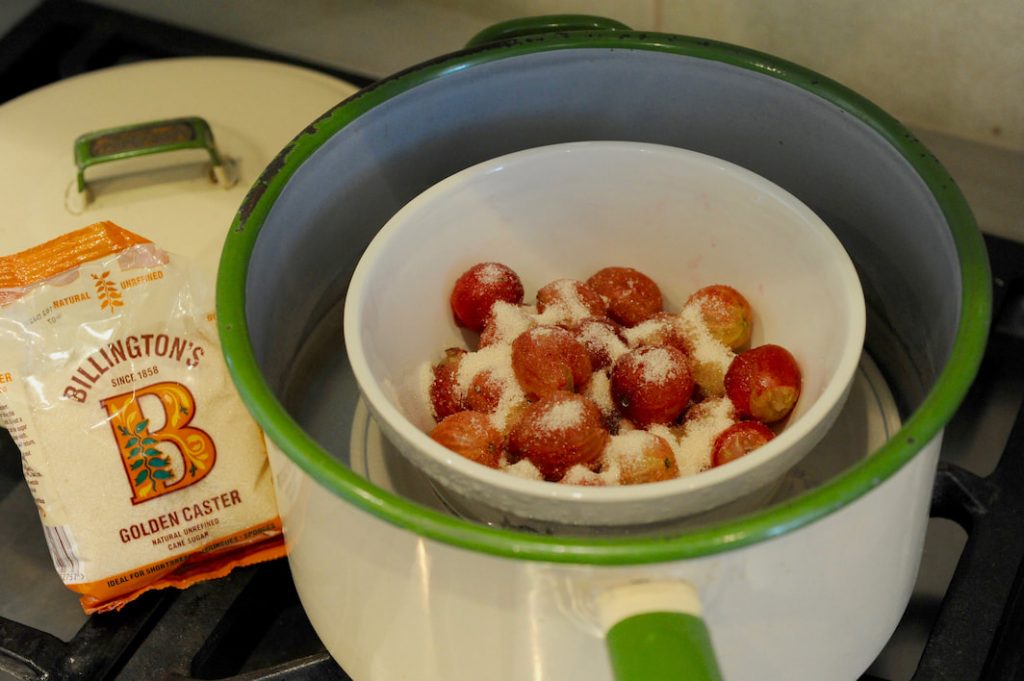
Before I indulge you with a titbit or two about this spiffing dessert, it has come to my attention that many folks assert that Gooseberry Fool is a rather chucklesome name for a dessert! For some bizarre reason or another, the title seems to tickle many Americans – an odd reaction, but it is known that they’re quite an eccentric bunch!
Darlings, the recipe from my 1903 edition of Mrs Beeton’s One Shilling Cookery Book, first appeared in the 1861 edition of Mrs Beeton’s Book of Household Management. However, it’s difficult to confirm if my recreation is definitely of Victorian origin because if the truth is told, Gooseberry Fool has quite a fruity history.
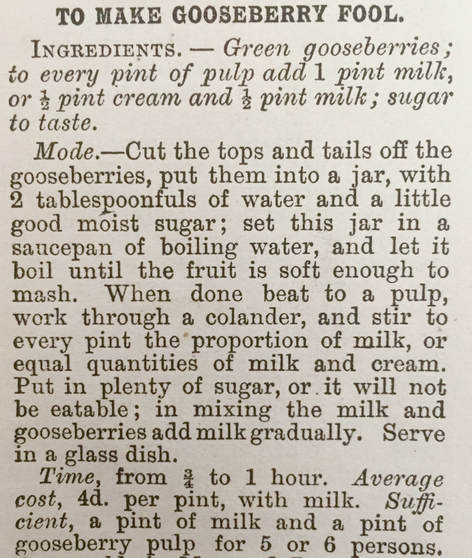
According to the jolly old internet, our beloved Gooseberry Fool was enjoyed by our forebearers as far back as the 14th or 15th century. However, there’s a huge time difference of a whole century to argue over, yet it’s highly possible this type of “foole” (as it was once called), commenced its culinary journey as a medieval dish. So far, there are no recorded recipes that could uphold this claim.
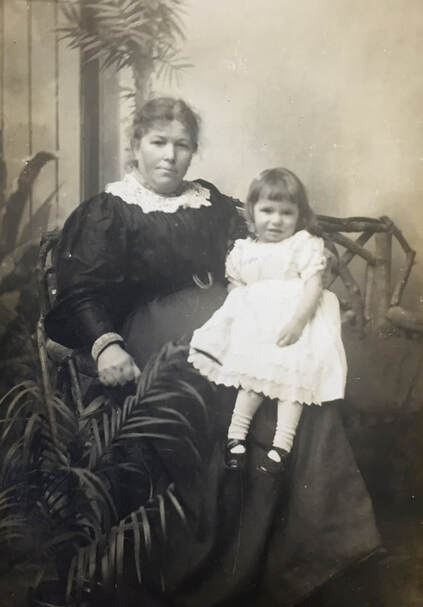
Thankfully, one can rest assure that many recipes for Gooseberry Fool have been traced to the 17th century – 1658 to be exact! Although, it is of great belief to some that there’s an elusive recipe stowed away somewhere that dates back to 1598.
I was intrigued to discover that our fabulous fool can be made with either a cooled custard-like base or whipped sweetened cream. You see, over the years, keen cooks from across the country would’ve rustled up this classic dish with either ingredient – I have only experienced the latter.
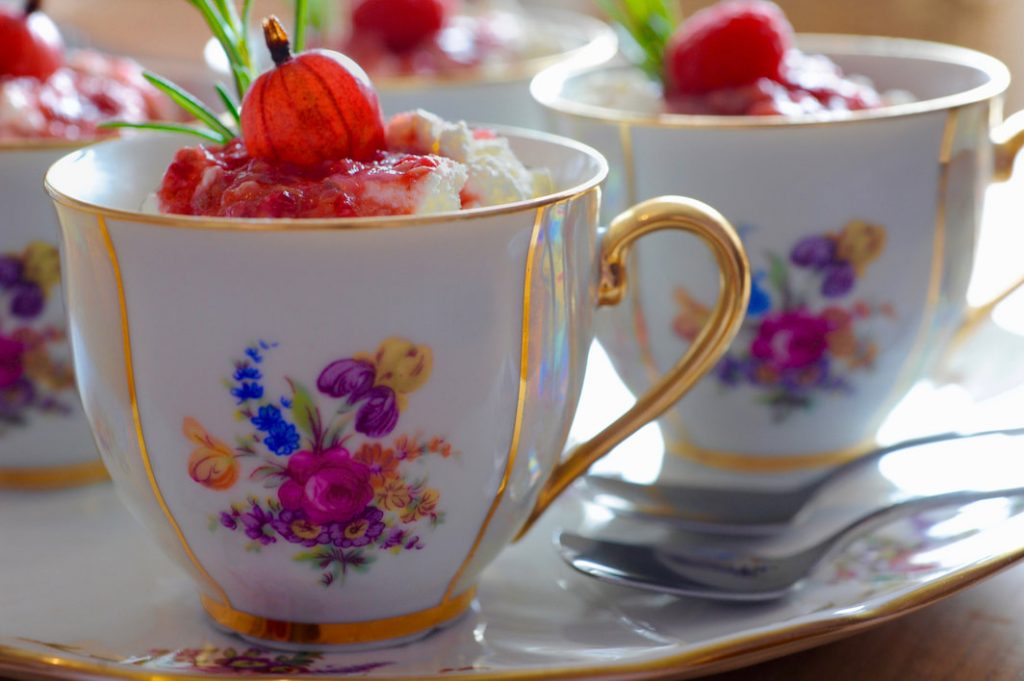
Darlings, purely for your delectation, Miss Windsor presents a couple of recipes from two distinctly different eras. A recipe from 1658 notes a custard base (following the execution of King Charles I, the year of 1658 was the last year Oliver Cromwell was the leader of the republic of England), and a Georgian or Regency recipe from 1802 (written during the reign of King George III) favours whipped cream.
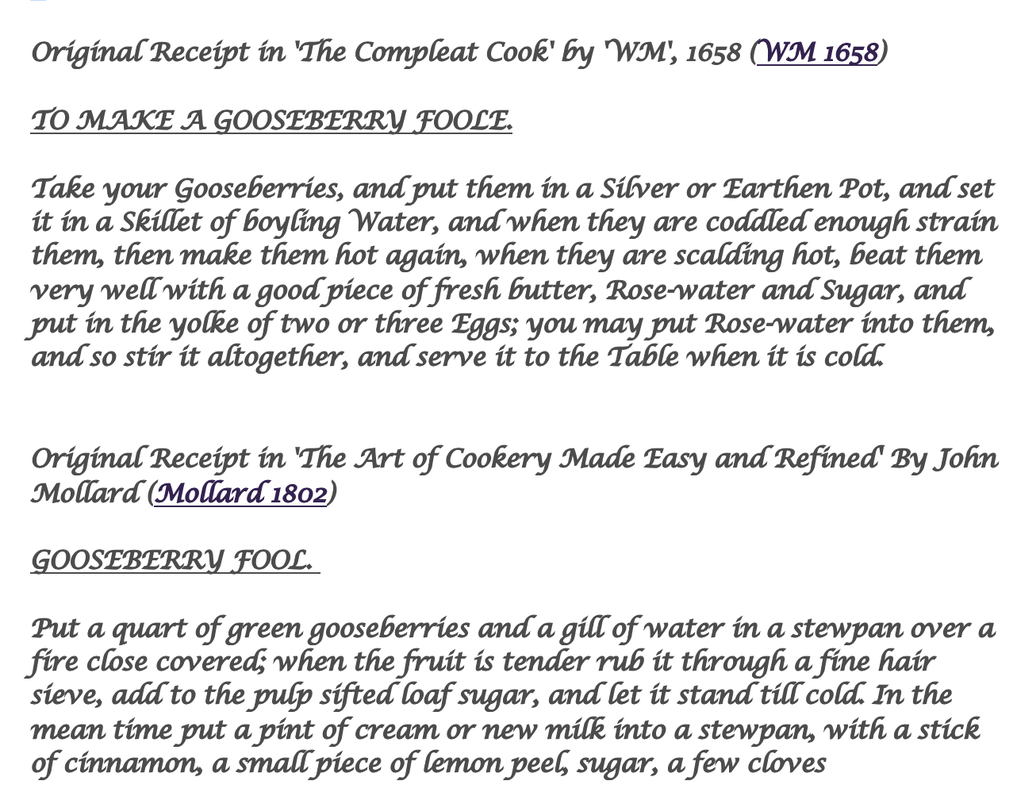
Of course, I recreated this dessert following traditional methods, which involved an old-fashioned pudding basin and potato masher. You see, Mrs Beeton suggests to steam the fruits in a “jar”, however, please do refrain from doing so, as when Miss Windsor followed her instruction the jar cracked then smashed to smithereens – a sturdy pudding basin will certainly do the job instead!

Before I retire to my parlour for a well-deserved G & T, I recommend one must serve their creation in style – a matching set of vintage bone China teacups would do the trick, or if one must, serve in tiddly yet elegant ceramic vessels.
I say, these exquisite, Haas and Czjzek, vintage teacups, as showcased above, once belonged to the rather wonderful and beauteous Valeria Wallace.
Miss Windsor x
ALL PHOTOGRAPHY BY MISS WINDSOR – EXCEPT FOR THE PHOTO OF GRANDMA GEORGINA & VALERIE WALLACE.

Miss Windsor’s Pink & Spicy Gooseberry Raspberry Fool
Equipment
- 1 large pudding basin or heat-proof bowl
- Electric hand whisk
- a selection of teacups or small vessels
Ingredients
- 540g (approx. 3 & 1/3 cups) pink gooseberries and raspberries
- a sprinkling of golden caster sugar (for the raw gooseberries)
- 1 x heaped tablespoon of golden caster sugar (for the pulped gooseberries)
- a couple of pinches of ground ginger & ground cinnamon
- 500ml (approx. 2 cups) double cream
- 1 heaped tablespoon of golden caster sugar (to sweeten the cream)
- for decoration: sprigs of rosemary or mint
- for decoration: pink gooseberries & raspberries
Instructions
- Prepare your gooseberries – ‘top and tail’ is the correct method – so use a knife to remove the stalks!
- Now, thoroughly wash your pink gooseberries.
- Transfer to a pudding basin or similar, and sprinkle generously with golden caster sugar.
- Promptly fill your kettle with water, then boil.
- Darlings, to prevent your pudding basin from cracking, place an old saucer on the bottom of a large saucepan.
- Once the kettle has boiled, carefully pour the water into the saucepan until it’s quarter filled.
- Moving on swiftly! Place your pudding basin onto the saucer, then carefully pour in the boiled water until it's about halfway up the basin.
- Transfer to the hob and boil the water on a high heat, then once boiling reduce to a simmer. Stir a few times with a metal spoon – the gooseberries are ready when broken-up and watery.
- Drain off the excess water using a colander, then place the colander into a large mixing bowl.
- Using a traditional potato masher, beat the gooseberries to a pulp through the colander.
- Darlings, now you’ll witness the ‘fruits of your labour’ – a bowl of glorious pink pulp!
- Roughly break the raspberries into the pink pulp, then give it a gentle squish-squash with the potato masher. Stir with a metal spoon until well blended.
- Onto the next step: stir in 2 heaped tablespoons of golden caster sugar – add more if too tart!
- Stir in 2 pinches of ground ginger, along with 2 pinches of ground cinnamon – add a trifle more if you desire!
- Using your electric hand-whisk or manual whisk, thoroughly whisk together the double cream and 1 heaped tablespoon of golden caster sugar. Whizz ingredients until blended and the cream has thickened.
- Darlings, now it's time to dazzle your guests with your exquisite taste! Just like Miss Windsor – go for vintage china teacups or something of similar quality, size, and appearance.
- Gently place 1 heaped dessertspoon of the creamy mixture into each teacup or small bowl. Then with a steady hand, drizzle 3 teaspoons of the gooseberry mixture on top – repeat process until you have 2 layers of each – finishing with a glorious layer of the fruity stuff!
- Now, decorate your delectable re-creation of Miss Windsor's Pink & Spicy Gooseberry Raspberry Fool with a sprig of rosemary/mint and a raw gooseberry/raspberry.
- Darlings, your culinary delight is now ready to be served – Voila!
The post Miss Windsor’s Pink & Spicy Gooseberry Raspberry Fool! appeared first on Miss Windsor's Delectables.
]]>The post Royal Windsor Pudding! appeared first on Miss Windsor's Delectables.
]]>Hello, darlings!
Welcome back to the royal household of Miss Windsor’s Delectables. Accompanied by the royal salute, I excitedly present Royal Windsor Pudding!
I say I’ve gone a bit pudding mad of late! You see, following the success of Mrs Beeton’s Spicy Suet Carrot Pudding, one felt compelled to have another go at recreating a Victorian slice of food history, or in this case, a Georgian slice! I remark, if a recipe was written between 1795 and 1837, this period is known as Georgian or Regency, hence Regency cookery.


I was instantly attracted to this recipe because of its original title of Windsor Pudding. Of course, one added “royal” to the title, which gives it a trifle more pizazz!
I presume you’ve already twigged that my darling sovereign, Her Majesty Queen Elizabeth II and I, share the same splendid surname of Windsor! Her Majesty is merely my beloved royal counterpart, and thus far, Miss Windsor has not had the pleasure of a formal introduction.
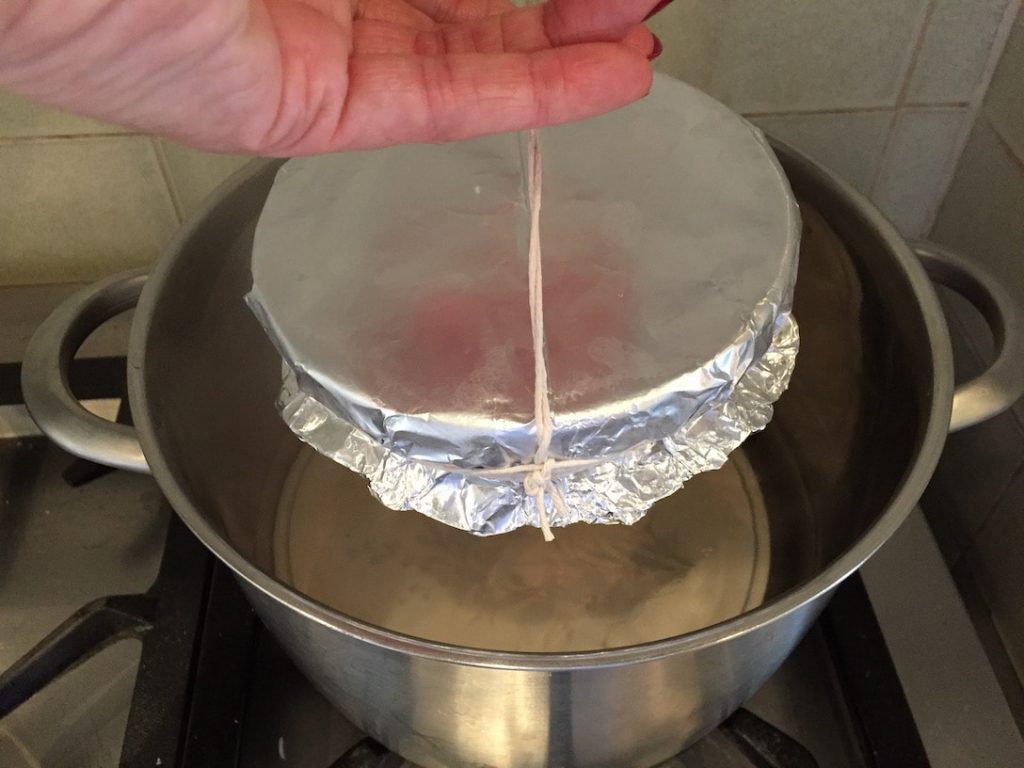
Moving swiftly on, I discovered this frightfully regal recipe in my 1906 edition of Mrs Beeton’s Book of Household Management, which I presume was featured in the first edition published in 1861 during the reign of Queen Victoria.
In fact, this recipe is much older than first thought. I was pleased to discover that Windsor Pudding (according to the jolly old internet!) commenced its culinary journey during the Georgian or Regency era (How fascinating!).

You see, whilst scouring through the archives of the Foods of England website (put link) I stumbled across Windsor Pudding – I say, thank goodness for modern technology! I was enthralled to read that in 1822 Mary Eaton first recorded this scrumptious pudding recipe in The Cook and Housekeeper’s Dictionary.
“Original Receipt in ‘The Cook and Housekeeper’s Dictionary’ by Mary Eaton (Eaton 1822);
WINDSOR PUDDING. Shred half a pound of suet very fine, grate into it half a pound of French roll, a little nutmeg, and the rind of a lemon. Add to these half a pound of chopped apple, half a pound of currants clean washed and fried, half a pound of jar raisins stoned and chopped, a glass of rich sweet wine, and five eggs well beaten, with a little salt. Mix all thoroughly together, and boil it in a basin or mould for three hours. Sift fine sugar over it when sent to table, and pour white wine sauce into the dish.”
My research also revealed how this regal pud received its title. Well, to start “Eaton” is Mary’s surname, and Eaton is located near Windsor in Berkshire, England. Mary may have also resided in Eaton or Windsor (who knows!), but nevertheless, the origins of this pudding are terribly obvious!

Darlings, I must admit I’m a tad baffled by Mrs Beeton’s Victorian version, as it’s peppered with discrepancies and lack of or choice of alternative ingredients. First off, the Georgian or Regency recipe calls for “suet”, and the Victorian recipe calls for no suet at all.
Evidently, Mrs Beeton (actually, I mean the real author of this recipe, as Mrs Beeton only ever developed ONE recipe in her lifetime, Useful Soup for Benevolent Purposes) replaced suet with “Carolina” or pudding rice, which is very odd as suet was all the rage in Victorian England.
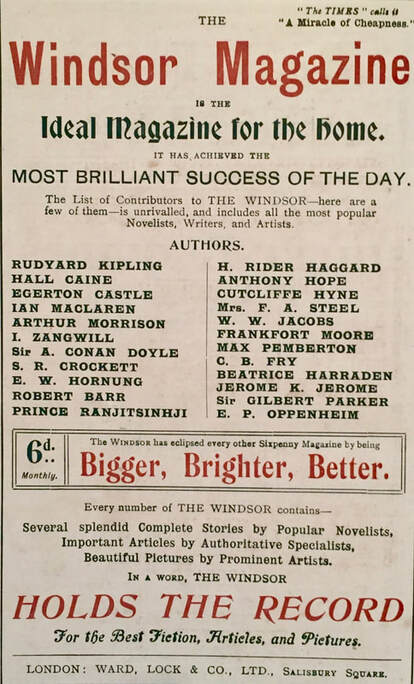
Now, regarding Mary Eaton’s recipe, what the heck is French roll? Of course, I consulted my resources but was unable to find sausage on it, so, if you have an inkling of a clue, please do indulge Miss Windsor.
Thankfully the ingredient of apple is included in both recipes, however, Mrs Beeton’s version failed to include chopped raisins, currants, and according to Mary’s Eaton’s instruction not even a drop of rich sweet wine, instead, half a teaspoon of lemon juice, which I increased to one tablespoon.
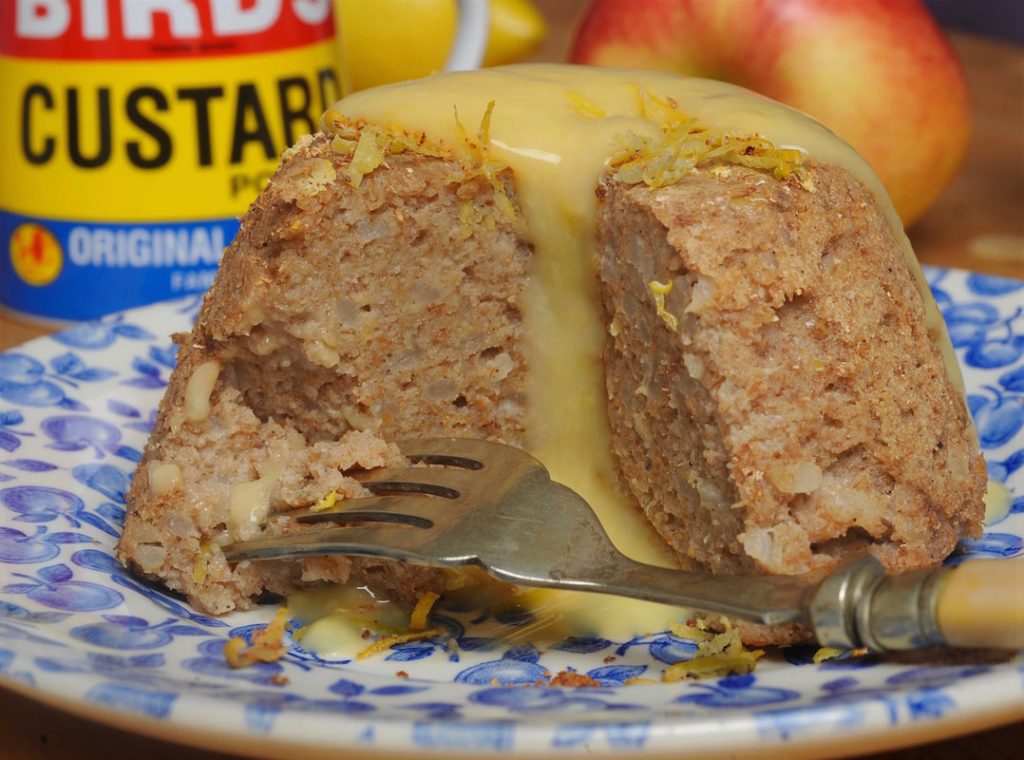
I say, the true anomaly of Mrs Beeton’s so-called recipe, is why on earth does it call for four “egg whites” instead of four whole eggs? And although I gave this recipe a jolly good crack of the whip! surprisingly it turned out like a steaming hot, pale coloured, virtually anaemic looking, wobbly blancmange.
But do not despair, as Grandmother Josie would often trumpet, “There’s no use crying over spilt milk!” – indeed, grannie! Always straight to the point with her pithy maxims, and often followed by, “If at first, you don’t succeed, try, try again”. So, Miss Windsor recreated this recipe once more with the addition of brown breadcrumbs, and thankfully it turned out just fine.
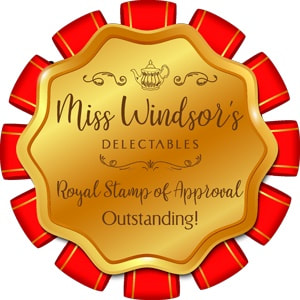
Before you dash off to your kitchen, I must proclaim that this pudding has been subject to intense scrutiny by Miss Windsor’s fine palate, and of course passed the taste test with flying colours. This magnificent pudding was awarded Miss Windsor’s Royal Stamp of Approval for superior flavour, queenly quality, and for its OUTSTANDING contribution to the arena of food history.
TIP: split the pudding mixture between two x 1-pint (570ml or 20 US fl oz) pudding basins, as this will cut down the steaming time considerably – only an hour or so, as opposed to three.
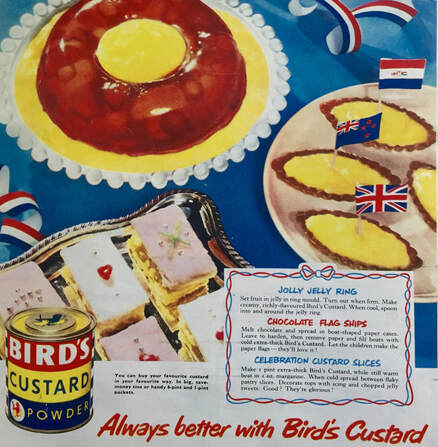
Serve each slice with a generous helping of Birds Custard – I do wonder if our trusty, old-fashioned, British household brand of Birds is a firm favourite of the royal family?
Enjoy the very best of royal fayre!
Miss Windsor x
ALL PHOTOGRAPHY BY MISS WINDSOR, EXCEPT FOR THE QUEEN MOTHER!
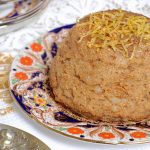
Royal Windsor Pudding
Equipment
- two x 1-pint (570ml or 20 US fl oz) pudding basins or one x 2-pint (just over 1.1 litres or 40 US fl oz) pudding basin.
Ingredients
- 6 large apples (such as Braeburn, Jazz, or Honeycrisp)
- 30g (1/2 cup) caster sugar
- 30g (3 tablespoons) Carolina or pudding rice
- 1 tablespoon of fresh lemon juice
- (1 cup) brown breadcrumbs
- zest of 1 lemon
- 4 egg whites
- milk
- zest of 1 lemon – for the garnish
Instructions
- Darlings, now it’s time to give your grubby little mitts a jolly good wash with Pears soap – the finest beauty product of Victorian England.
- First off, prepare the breadcrumbs and set to one side.
- Using a medium saucepan, generously cover the rice with milk and boil gently until tender. Drain well.
- Chop the apple and stew in a large saucepan until soft. Then with a wooden spoon rub through a fine sieve, and stir in the rice, sugar, lemon juice, lemon zest, and breadcrumbs.
- Whisk egg whites until stiff, and gently fold into the mixture.
- Now, place an old saucer onto the bottom of a large saucepan (this will prevent the basin from cracking) then fill with water, about half-way up the basin, and immediately put onto boil.
- Take two small pudding basins or an extra-large one, grease with butter and three-quarters fill with the mixture.
- Time to prepare the basins for steaming. Cut a large piece of greaseproof paper and foil. Place the foil piece on the kitchen counter followed by the greaseproof paper on top, and lightly grease with butter.
- Holding both pieces together, make a pleat in the centre, then gently place over the basin and mould it around the edges.
- Using a long piece of string, tightly wrap it around a few times under the “lip” of the basin and secure with a knot or two.
- Make a handle by threading the string from one side to the other. Repeat and secure.
- Trim off the excess paper/foil and tuck both layers under neatly, then place the basin into the saucepan and cover with the lid.
- Regularly top up with water, as you wouldn't want your “regal” pudding to boil dry!
- At the 1 hour mark (1-pint basin) or 2 & 3/4 hours (2-pint basin) check if they’re cooked. Insert a skewer through the foil/paper layer, and if it comes out clean it’s ready, if not keep steaming for a while longer.
- Garnish with lemon zest and serve hot with lashings of custard!
The post Royal Windsor Pudding! appeared first on Miss Windsor's Delectables.
]]>The post Miss Windsor’s Wartime Girdle Scones! appeared first on Miss Windsor's Delectables.
]]>Hello, darlings!
Just in the nick of time for National Cream Tea Day (Friday 28th June 2019), I excitedly present Miss Windsor’s Wartime Girdle Scones (How spiffing!).
I also wholeheartedly dedicate this recipe, admittedly a trifle late, to the recent celebrations of the 75th anniversary of the D-Day Landings, which took place on the 6th June 2019, of course, the actual real thing took place on the 6th June 1944.
“Ummm, excuse me, Miss Windsor, you mentioned “girdle”, but isn’t that a ladies undergarment worn to disguise one’s jelly belly?” Well, my dears, you’re absolutely correct, but not in the case of wartime cookery. You see, most folks were at their healthiest and about 10 pounds lighter back then, so there was no need for a girdle! Please do read on to find out more……..
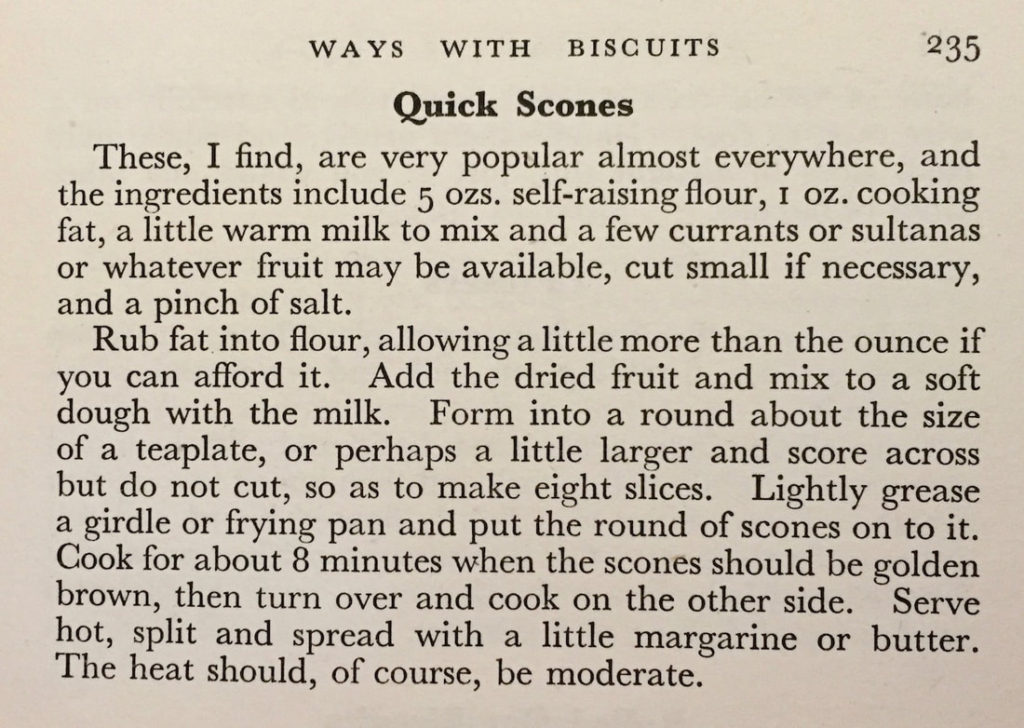
I must divulge that this triumphant recipe goes by the original title of Quick Scones (traditionally cooked on a GIRDLE), which I discovered on a fat splattered, sepia-tinged, discoloured page, lurking near the end of Irene Veal’s spectacular cookery book, Recipes of the 1940’s, first published in 1944.
By the way, Irene Veal dedicated her book to Lord Woolton – who evidently, TAUGHT BRITISH WOMEN to COOK WISELY.
I recreated this recipe with self-raising flour, a little warm milk, a small handful of chopped sultanas, 1oz (30g) of one’s 8oz sugar ration, a pinch of baking powder, and our British favourite of “beef dripping’, collected from last Sunday’s roast dinner – a one-off treat for the Miss Windsor household!

Darlings, Grandmother Josie often shared with Miss Windsor one of her fondest, childhood, wartime memories, of a slice of bread slathered with beef dripping. A treat she looked forward to receiving, only if she’d been a good girl, and did a grand job of scrubbing the front doorstep with Vim Scouring Powder!
Of course, one could only indulge in such a treat, if one was lucky enough to get their hands on a joint of beef. For reference: the weekly meat rations during wartime Great Britain was “1s. 2d” (1 shilling & 2 pence) per adult, which during the year of 1944, equated to a little over “1 lb.” (450g) of meat including the bone.
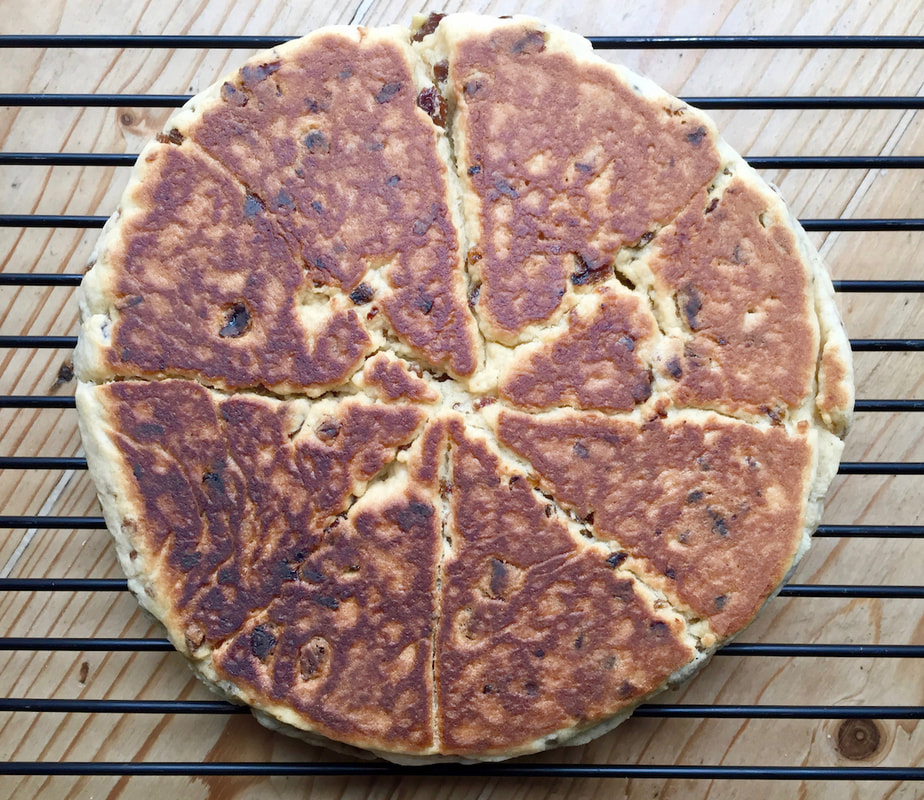
I remark that I only decided to rustle something up for National Cream Tea Day on Wednesday just gone. Therefore, in search of something hasty, relatively easy, and in the spirit of cream tea and British wartime cookery, one was delighted to stumble across this gem of a recipe.
But to Miss Windsor’s utter dismay, after several hours slogging away over Grandmother’s Josie’s, vintage, wrought iron GRIDDLE pan (that’s right, Miss Windsor doesn’t possess a GIRDLE!) one soon realised, that Irene Veal’s recipe wasn’t so easy and hasty after all!

I expect by now, in the context of cookery, you’re gagging to know what a girdle is. Well, it’s merely similar to a griddle, except it’s suspended over the fire/stove by a long metal chain – and there you have it.
You see after two jolly good goes at recreating Irene Veal’s recipe I was clean out of beef dripping. As one can imagine, Miss Windsor was on the brink of despair, so in an attempt to remain focused, one repeatedly muttered: “Just Keep Calm and Carry On!”
I say, thank goodness for positivity, quick thinking, and a British stiff upper lip! so I reached into my refrigerator and emerged with the last of my “margarine” ration – phew! Panic over.
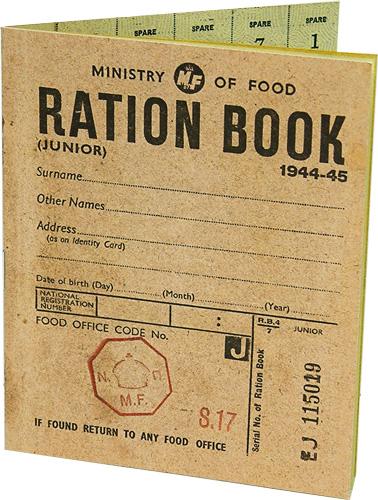
Darlings, nigh to the end of my “bakeathon”, I discovered that a moderate heat, as suggested by Irene Veal, unfortunately, burnt the dough not just once but twice. So, at the start of my third and last round, I vowed to keep the heat as low as possible, even if it took an age for it to thoroughly cook through. Thus thirty minutes later, Grandmother Josie’s, vintage, wrought iron griddle pan eventually produced a culinary triumph.
When I consulted Irene Veal’s cookery book, I soon realised why my scone dough, in previous rounds, ended up burnt. Well, to start, during the wartime years there was something called National Flour, which was different from our usual white type because ultimately less wheat was being imported to Great Britain.

So, to feed the nation, more flour was extracted from the grain, thus produced a nourishing but rather off-putting greyish coloured flour.
Irene Veal advises the reader: When, and if, white flour is again used, a little less liquid, rather more fat and slightly lower oven temperatures and longer cooking will be necessary – Miss Windsor couldn’t agree more; just a shame one did not know of this until three whacks later.
And for those who may be wondering, who the heck is Lord Woolton? He was the wartime Minister of Food (glorious food!), who chummed up with Sir Jack Drummond, a nutritional biochemist and scientific adviser to the Ministry of Food.

You see, their shared passion to improve the nation’s diet and to eradicate malnutrition, eventually led to a national food policy. As a result of this, measures were put in place to feed the British public back to good health. Therefore, during the chilly month of January 1940, every man, woman, and child was issued with a ration book for butter, bacon, and sugar.
Then in March 1940, followed the rationing of meat, preserves, tea, margarine, cooking fats, milk, and so on. So whether you were rich or poor, all members of society received adequate nutrition to survive the war. In fact, meat rationing finally ended many years after WWII, on the 30th June 1954 – Hallelujah!
Enjoy recreating a British slice of wartime food history!
Miss Windsor x
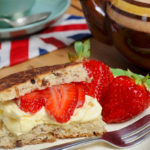
Miss Windsor’s Wartime Girdle Scones
Equipment
- a griddle, girdle, or thick based frying pan!
Ingredients
- 140g (just over 1 cup) self-raising flour
- 30g (just under 1/4 cup) of beef dripping, lard, butter, or margarine
- 30g (just under 1/4 cup) caster sugar
- small handful of any dried fruit – roughly chopped.
- 6 soup spoons of warm milk (sorry, it was the only spoon I could find at the time!)
- 1/2 of 1/4 of a teaspoon of baking powder
Instructions
- Squeaky clean hands at the ready – give them a scrub with some carbolic fragranced Lifebuoy soap!
- Sieve the flour and baking powder into a large mixing bowl, then lightly rub in the fat with your fingertips.
- Add the chopped dried fruit and sugar. Mix well.
- Warm the milk to a tepid temperature, then add a spoonful at a time. Stir with a knife until thoroughly combined and starts to form a nice sticky dough. Finish off with your hand until the bowl is clean. Transfer to a floured surface.
- Knead lightly and roll out to the size of a tea plate, and score with a knife as to mark 8 slices.
- Lightly grease the griddle, “girdle”, or frying pan and heat at the lowest setting. Wait for a couple of minutes, then gently transfer the dough round onto your chosen pan.
- Cook each side until well risen and dark brown (not burnt!). It can roughly take 10 to 15 minutes on each side, or even a tad longer.
- Serve hot with butter and jam, or clotted cream and freshly sliced strawberries.
The post Miss Windsor’s Wartime Girdle Scones! appeared first on Miss Windsor's Delectables.
]]>The post Miss Windsor’s Chocolate Orange Cream Roll! appeared first on Miss Windsor's Delectables.
]]>Hello, darlings!
You may already know, that our beloved sovereign, HM Queen Elizabeth II is a “chocoholic” of the incredibly ardent and incurable kind. And so is Miss Windsor’s beloved grandmother Josie who just so happens to share the same birth year of 1926 with Her Majesty.
So, with this in mind, accompanied by a zingy twist of orange, I recreated the frightfully fabulous Chocolate Cream Roll to celebrate Her Majesty’s official birthday of Trooping the Colour – this year it takes place on Saturday the 13th June 2020.
Miss Windsor shall serve her queenly recreation to an assemblage of guests at her terribly splendacious afternoon tea party, in other words, a jolly good “royal knees-up”!
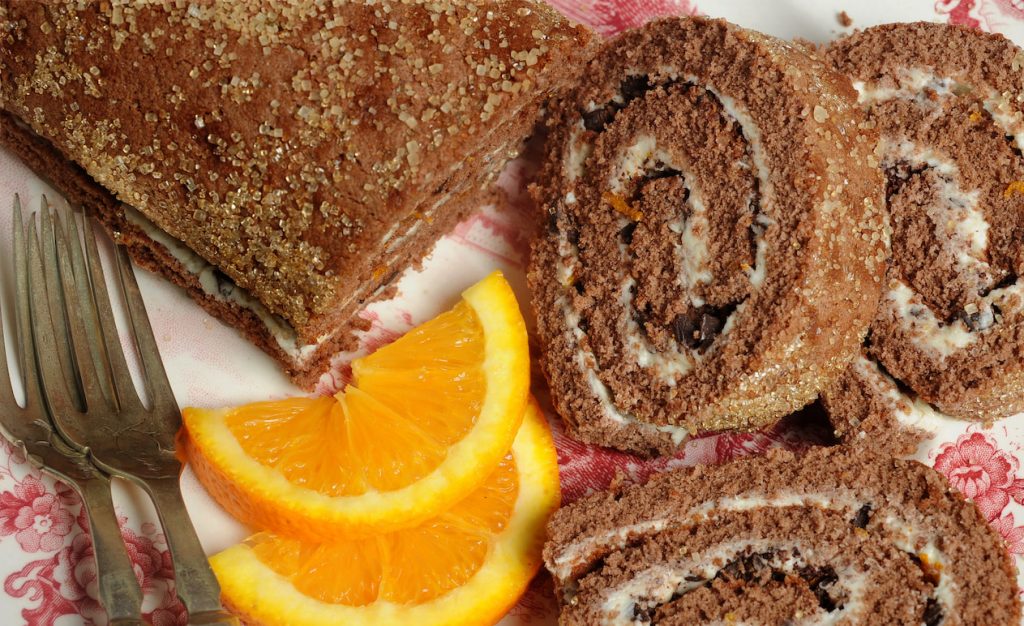
For those who have a keen interest in food history, I’m sure you’ll be pleased to know that I discovered this recipe in my 1935 edition of the Radiation Cookery book – a cherished gift from my gentleman friend, Sir Brian of Church Street Market, London.
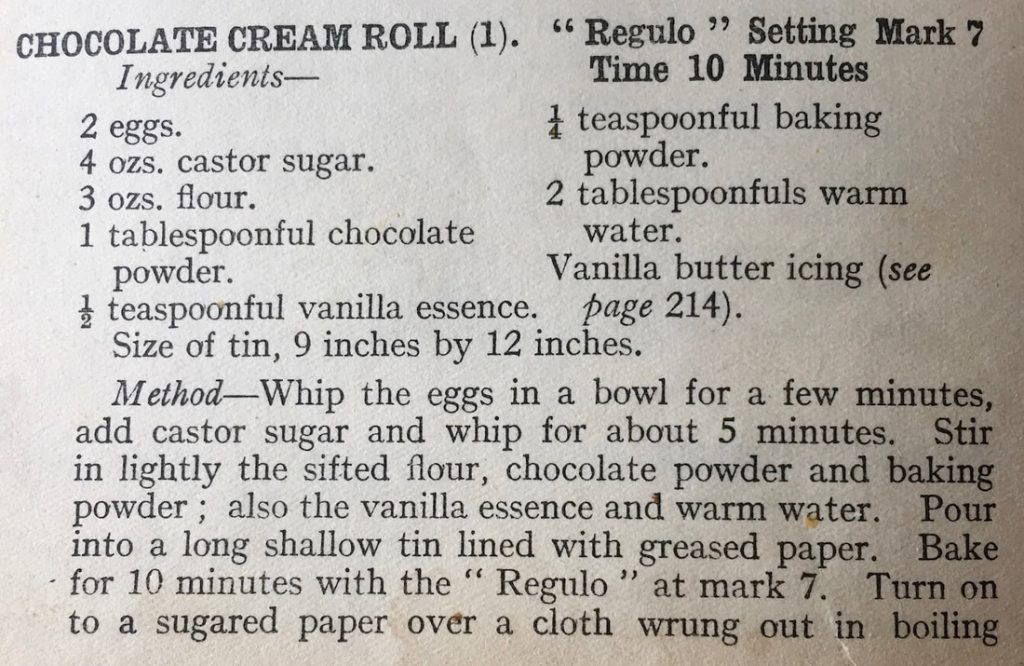
Darlings, in the spirit of Her Majesty’s official birthday, Miss Windsor’s Chocolate Orange Cream Roll is most certainly the perfect sweet treat to tickle one’s fancy, so to speak! So, please indulge in slice or two of this incredibly light, temptingly tangy, devilishly moist, rich, and chocolatey, sumptuous delight – slathered with a luxurious layer of orange buttercream icing.

Oh, and this decadent choco-orange beauty is best enjoyed with a cup of your favourite Rosie Lee – for those who aren’t privy to a verse or two of cockney rhyming slang, Rosie Lee is indeed a cup of tea! Of course, tea is the most appropriate liquid refreshment to be quaffed from a bone china cup and saucer, whilst one enjoys the royal delights of an afternoon tea pageantry of goodies.

But if you fancy something a trifle stronger, Miss Windsor permits you to a sip or two of the Queen’s favourite tipple of Gin and Dubonnet – to be supped from a crystal glass tumbler!
Darlings, before you toddle off to your kitchen, I’m proud to announce that this exquisite sweet treat fit for a Queen has been awarded Miss Windsor’s Royal Stamp of Approval.

GOD SAVE THE QUEEN!
Miss Windsor x
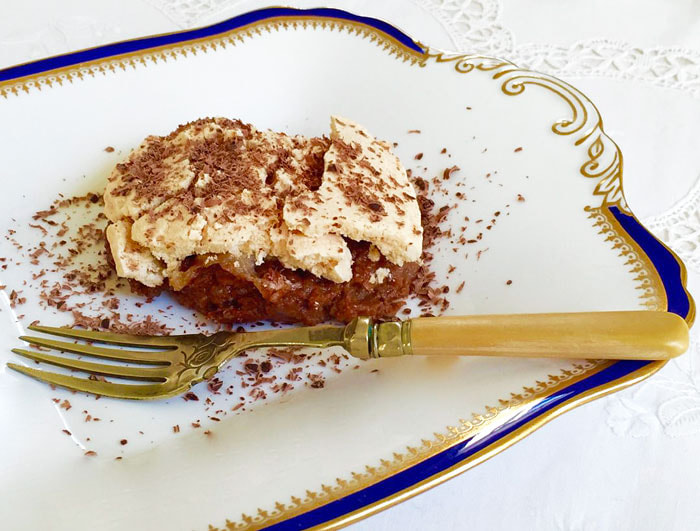
Darlings, if you fancy learning more about Trooping the Colour, or recreating another royal recipe fit for a QUEEN! Then please do take a look at MISS WINDSOR’S CHOCOLATE QUEEN PUDDING!
ALL PHOTOGRAPHY BY MISS WINDSOR

Mrs Windsor’s Chocolate Orange Cream Roll!
Equipment
- electric hand-whisk / food processor
- shallow baking tin – 9 x 13 inches or 23 x 33 cm (approx.)
Ingredients
Chocolate Orange Sponge
- 2 eggs
- 120 g (just under 1/2 cup) caster sugar
- 80 g (3/4 cup) plain flour
- 1 tbsp cocoa powder (level)
- 1 teaspoon of orange extract
- 1/4 level teaspoon of baking powder
- 2 tbsp fresh orange juice
- a sprinkling of brown sugar
Orange Butter Cream
- 125 g (just over 1/2 cup) unsalted butter
- 300 g (3 cups) finely sifted icing sugar
- 1 tsp orange extract or orange liqueur (add more to taste!)
- finely grated orange zest
- roughly chopped dark chocolate chips
Garnish
- fresh orange slices
Instructions
- Squeaky clean hands at the ready!
- Pre-heat your oven to 220 *C / 200 Fan / 425 *F / gas mark 7.
- Using a large mixing bowl whisk the eggs and caster sugar until pale and creamy.
- With a steady hand stir in the sifted flour, chocolate powder, and baking powder, then add the orange extract and fresh orange juice. Mix gently with a wooden spoon.
- Prepare the baking tin with greaseproof paper.
- Pour in the batter and smooth over with a palette knife, then tip the baking tray from side to side to even out the mixture.
- Bake for exactly 6 minutes.
- Darlings, now with great care dampen a cloth with boiling water (I recommend an old tea towel) then place a piece of greaseproof paper over the top and sprinkle with brown sugar.
- Turn out your creation onto the sugared paper and remove the cooked paper from the sponge, then roll it up!
- Allow to completely cool.
- Once cooled, it’s time to whip-up the Orange Butter Cream filling! So, using your modern day appliance or a wooden spoon, simply beat together the butter, icing sugar, and orange extract or a drop of orange liqueur until pale in colour and creamy. Add a drop of milk if it’s a little stiff.
- Darlings, now this step requires the aid of light hands! Carefully unroll the sponge and spread with the filling, then scatter with orange zest and a handful of roughly chopped chocolate chips. Gently roll back up and leave to stand for a few hours.
- When ready to serve cut into equal portions and present on a pretty plate. Garnish with a slice of fresh orange – voila!
- Serve to your delightful guests with a cup of Rosie Lee!
The post Miss Windsor’s Chocolate Orange Cream Roll! appeared first on Miss Windsor's Delectables.
]]>The post Miss Windsor’s Chocolate Queen Pudding! appeared first on Miss Windsor's Delectables.
]]>Hello, darlings!
It’s an absolute pleasure to present Miss Windsor’s spin on a frightfully decadent and regal recipe fit for a QUEEN – Chocolate Queen Pudding!
I recreated this palate teasing, chocolaty kind of luxury Bread Pudding to celebrate our sovereign’s “official” birthday of Trooping the Colour, which takes place on Saturday the 8th of June 2019.
I must say darlings, my beloved grandmother Josie and Her Majesty The Queen both entered this magnificent world during the year 1926 – known as the roaring ’20s! And suffice to say, both ladies are of the greatest personage and have many things in common, one being they are “chocoholics” of the incredibly ardent and incurable kind (Oh, I say!).

Therefore, with chocolate firmly in mind, I scoured the discoloured and rather frayed pages of my 1935 edition of the Radiation Cookery Book and stumbled upon this mouth-watering recipe, which I jazzed up a tad with a smattering of spice and a zing of lemon and orange zest.
In fact, this particular cookery book was a generous gift bestowed upon Miss Windsor by her darling friend Sir Brian of Church Street, London.

Now, for those who are wondering what the heck is the Radiation Cookery Book, well it’s simply a cookery book that accompanied the “Regulo” controlled New World Gas Cooker. And for those who are familiar with gas cookers/ovens, especially folks in Great Britain, the term “gas mark” (i.e gas mark 5) derived from the term “Regulo mark” – and there you have it!
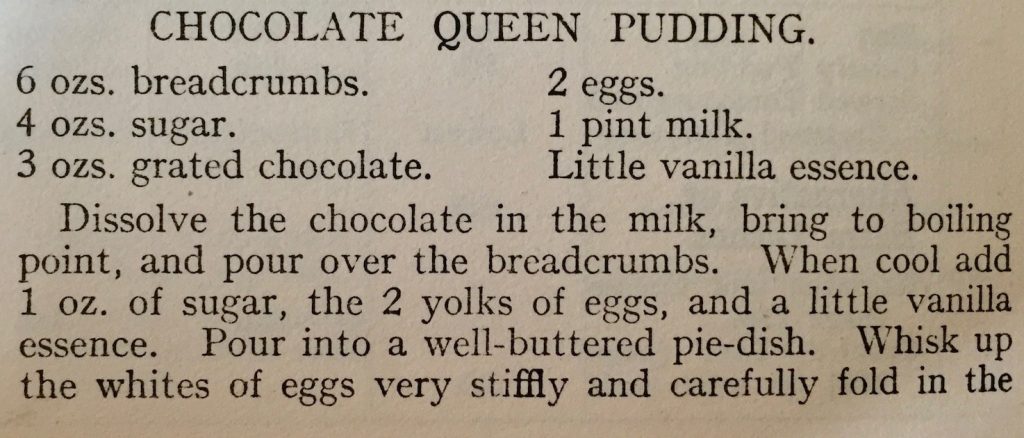
Darlings, Miss Windsor must admit she is a tad bit envious that her beloved Queen Elizabeth II celebrates two birthdays each year. The first being her “actual” birthday on the 21st April – this year she turned the grand old age of 93! Then on the second Saturday of June, Her Majesty commemorates her official birthday in the form of a public celebration – a parade known as Trooping the Colour, a tradition since the reign of King George II.

“I say, Miss Windsor, could you kindly reveal a few details about this vibrant celebration,” of course, my dears! In a nutshell, Trooping the Colour, as a birthday parade, commenced its royal journey due to the infamous British weather – which I’m sure most of you are well accustomed to!
Conflicting records dictate, that King George II was born in October or possibly November, but thankfully all agree the same year of 1683. Of course, the weather in Great Britain is absolutely dismal during these months, and obviously hindered His Majesty’s wish to celebrate his birthday with a jolly good royal “knees-up” of a public parade.

So, for the first time in 1748, the King of England planned a joint celebration of his birthday with an annual military parade of Trooping the Colour, which possibly dates back to the reign of Charles II (17th century). Apparently, the British Army would line up and display their regimental flags known as “colours”, then officers/soldiers would march between the ranks of troops and familiarise oneself with their regiment, which was imperative for the battlefield.
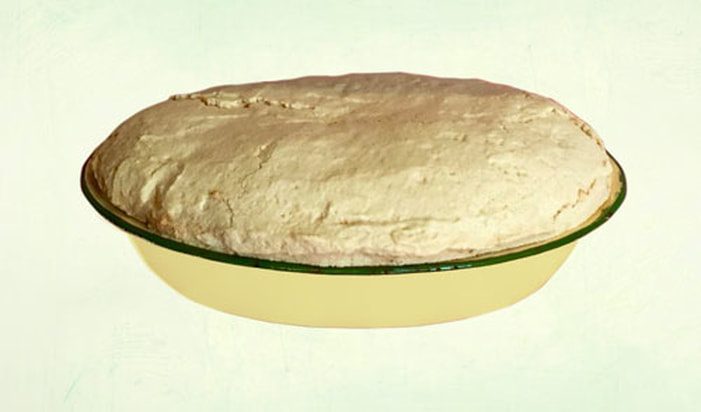
Nevertheless, the summertide military parade combined with King George II’s birthday certainly kicked off a tradition that our darling sovereign, Her Majesty Queen Elizabeth II still follows today. And since 1987 Her Majesty prefers to observe the parade from the comfort of her royal carriage, as opposed to inspecting troops from horseback, which of course, was always conducted in a ladylike pose of “side saddle”, whilst sporting her full military regalia.
Okey dokey darlings, without further ado, please hotfoot into your kitchen and prepare for some culinary magic of bygone days – regal style, of course!
GOD SAVE THE QUEEN!
Miss Windsor x
ALL PHOTOGRAPHY BY MISS WINDSOR – EXCEPT FOR THE QUEEN & GRANDMOTHER JOSIE!

Miss Windsor’s Chocolate Queen Pudding
Equipment
- coffee grinder or similar implement!
- electric whisk
- pie dish (medium size)
Ingredients
- 210g (2 & 1/3 cups) brown bread crumbs
- 80g (1 cup) grated dark chocolate
- 30g (just under 1/4 cup) caster sugar – for the pudding mixture.
- 90g (1 cup) caster sugar – for the meringue.
- 1 pint (20 US fl oz.) whole milk
- 2 eggs yolks
- 2 egg whites – for the meringue.
- zest of a lemon
- zest of a small orange
- optional: grated nutmeg
Instructions
- Darlings, please wash those grubby little mitts of yours in readiness for some "regal" culinary action!
- Preheat your oven to 140*C / 120*C Fan / 275*F / gas mark 1.
- Prepare your breadcrumbs by whizzing the brown bread in a coffee grinder or similar kitchen implement!
- Grate the chocolate using a cheese grater – be careful not to shred a finger or two!
- Transfer the breadcrumbs to a large mixing bowl.
- Now, reach for a large saucepan and pour in the milk, followed by the grated chocolate.
- Bring to the boil, then remove from the hob and sprinkle over the breadcrumbs and stir.
- Allow the mixture to cool completely.
- When the mixture has cooled, pour in (30g / just under 1/4 cup) of caster sugar.
- Add 2 egg yolks, zest of a lemon and orange, and some grated nutmeg, then merrily stir together with a wooden spoon.
- Grease your pie dish and gently pour in the mixture – set to one side.
- Using an electric whisk, beat the egg whites until stiff n’ dry, then fold in the remaining caster sugar.
- With a pallet knife gently spread the meringue over the top of the pudding, then place on the middle shelf of your oven and bake for approximately 1 & 1/4 hours.
- Your pudding is ready when the meringue has risen and browned a little.
- Darlings, serve this scrumptious pudding on your best bone china vessel. Miss Windsor opted for an elegant dish by "Spode" – just perfect for Her Majesty The Queen’s dining table!
- GOD SAVE THE QUEEN!
The post Miss Windsor’s Chocolate Queen Pudding! appeared first on Miss Windsor's Delectables.
]]>The post Mrs Beeton’s Hasty Pudding (Nutmeg & Vanilla Tapioca Pudding) appeared first on Miss Windsor's Delectables.
]]>Hello, darlings!
Miss Windsor excitedly presents Mrs Beeton’s Hasty Pudding (Nutmeg & Vanilla Tapioca Pudding).
Now, Miss Windsor has no time for “dilly-dallying”, so without further ado, one shall get straight to the point – chop, chop! about this subtly sweet yet rather wholesome member of the British milk pudding family.
You see, as far as I know, hasty pudding or more commonly known as tapioca pudding has been a staple of our beloved sweet course since the 1800s – well, a lot less so in today’s modern world, but suffice to say it’s certainly making a glorious comeback!
Oh, and I must quickly mention that I’m “chomping at the bit” as I excitedly present this recipe as my first offering to “At Home With Mrs Simkins & Miss Windsor” – our new collaboration which opens with an all guns blazing HASTE-OFF, hence my recreation of Mrs Beeton’s HASTY PUDDING.

Darlings, and if you haven’t already guessed, just as it says on the tin we are indeed rustling up a quick-fire pudding that one can recreate in a jiffy, or in a haste in this case – just twenty minutes will do the trick. Created with tapioca (of course!) milk, brown sugar, vanilla flavouring, and nutmeg – the very best of British fayre! In fact, my darling Mrs Simkins opted to make a baked version with flour, milk, brown sugar, butter, egg, and nutmeg. She has also made an American version with cornmeal: what versatility!
Moving swiftly on, hasty pudding which was traditionally made with either sago or tapioca and sometimes with oatmeal has been quite a thing in England since the late sixteenth century. In fact, the Victorians absolutely adored this scrumptious, easy on the purse strings, economical dish which was a rather appreciated delicacy of its time. Of course, one would serve this delightful pud with a splash of cream and a dollop of jam – I’m rather fond of Tiptree Strawberry Jam by Wilkin & Sons Ltd.
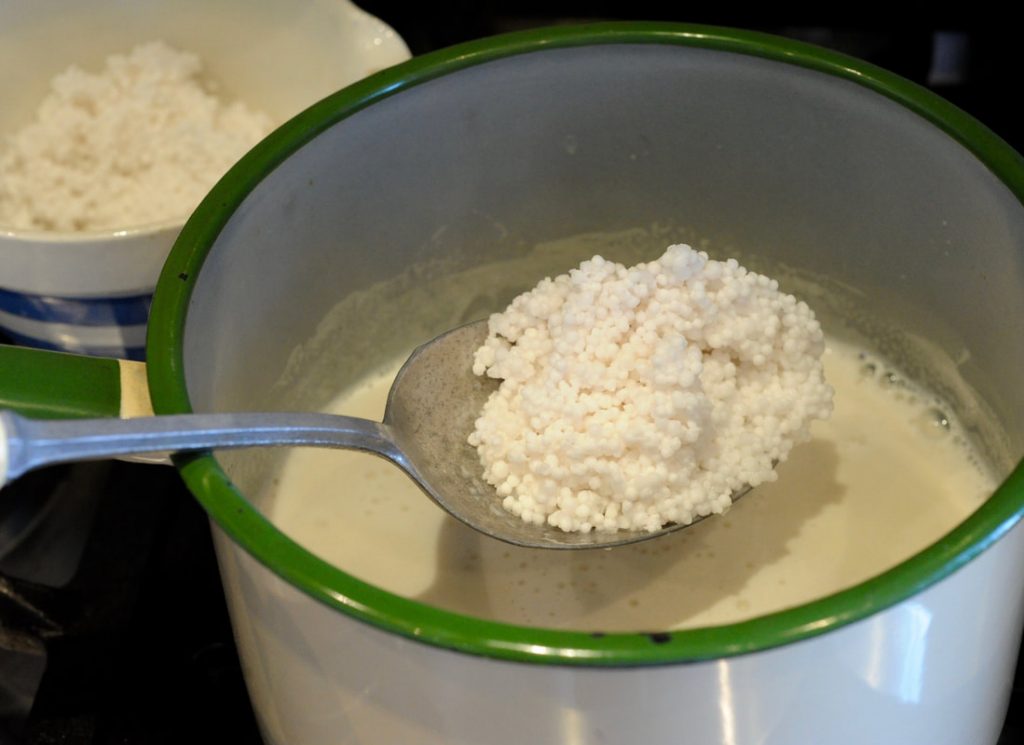
So, if you’re a fan of old-fashioned traditional British food such as rice pudding, then you’re going to fall head over heels with this old-school, traditional creamy dessert bestowed the grand title of Mrs Beeton’s Hasty Pudding (Nutmeg & Vanilla Tapioca Pudding). I dare say, many of you will have wonderful memories of something similar yet equally indulgent whipped up to perfection by your school cook – school dining at its best!
Darlings, to be brutally honest, when I was a snipper, I was rather averse to tapioca pudding and so used to dread the day it appeared on the school dinner menu – yuck! I couldn’t even bear to blink an eye at it, as it reminded me of a sloppy gooey bowl of white jelly balls that had been torn from the depths of a slippery slimy pond – frogspawn springs to mind!

I must say, my beloved culinary marvel, Mrs Beeton was a huge fan of tapioca and states in her culinary masterpiece Beeton’s Book of Household Management which was first published in 1861, “Its nutritive properties are large, and as a food for persons of delicate digestion, or for children, it is in great estimation” – well versed, Mrs Beeton! Of course, recipes for hasty pudding, tapioca pudding, tapioca milk-based pudding, plus tapioca soup were given pride of place in her culinary bible.
Darlings, hurry along now; there’s no time to spare, as one must prepare to recreate Mrs Beeton’s Hasty Pudding. However, before you get cracking I’m afraid to say that you’ve been a trifle misled, as you’re going to need longer than twenty minutes; in fact, twelve hours to be precise!
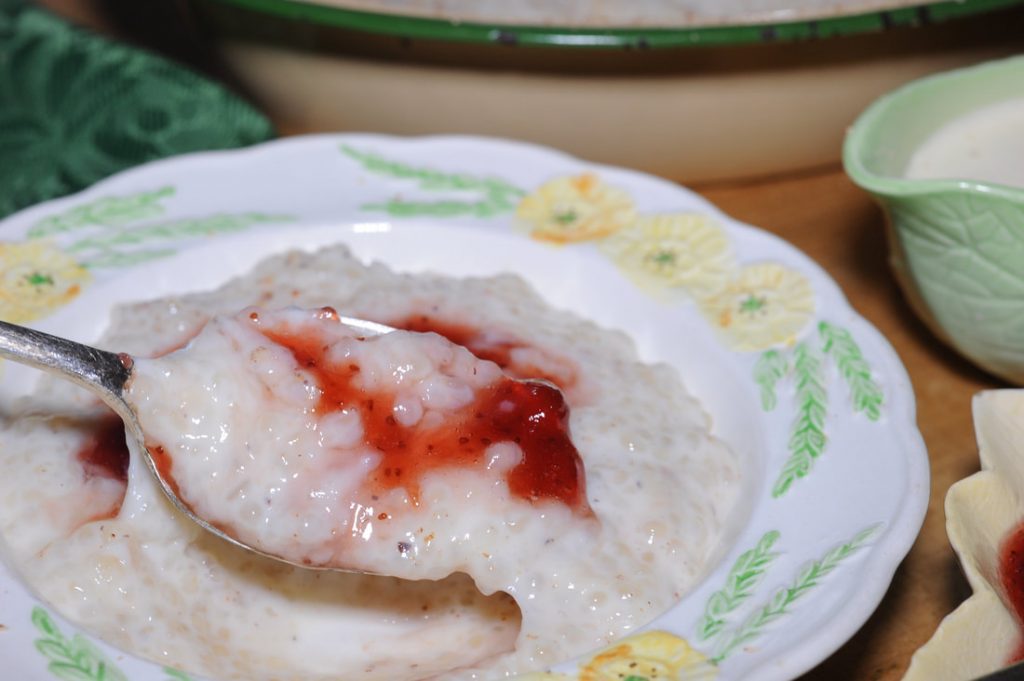
You see, one must soak the tapioca pearls for at least twelve hours in water (some say a couple of hours will do, but don’t listen to them!) in order to soften the pearls which will thicken the mixture. And, by the way, do not succumb to the convenience of instant tapioca, the instant type doesn’t work so well, and in any case, Miss Windsor will not tolerate idle hands!
Apologies, if I’ve “upset the applecart,” so to speak, but the truth is darlings Mrs Beeton’s recipe is not so hasty at all! I’m afraid there’s nout Miss Windsor can do about that; as a grapple or two is most expected when recreating a slice of food history.
Darlings, tick tock, tick tock – hurry along now, put your skates on, then dash off to your kitchen and give your tapioca pearls a jolly good soaking!
See you back here in twelve hours – don’t be late!
If you have a bit of a sweet tooth, may I recommend:
MRS BEETON’S SERIOUSLY SCRUMPTIOUS LEMON & COCONUT CAKE!
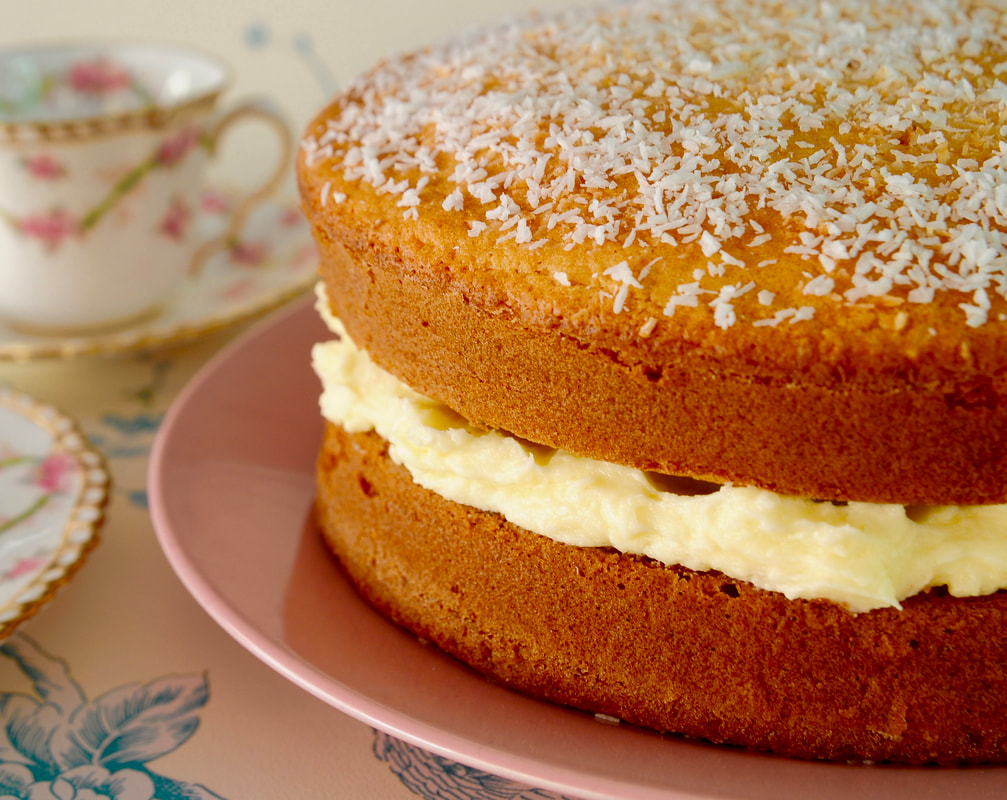
Miss Windsor x
ALL PHOTOGRAPHY BY MISS WINDSOR EXCEPT FOR PHOTO OF AUNTY BETTY!

Mrs Beeton’s Hasty Pudding (Nutmeg & Vanilla Tapioca Pudding)
Equipment
- Vintage or decorative serving dish
Ingredients
- 220 g (1/2 cup) tapioca
- 1 litre (34 US fl oz.) water
- 750 ml (26 US fl oz.) whole milk
- 100 g (1/2 cup) brown sugar
- 1 tbsp vanilla essence
- pinch of salt
To Serve
- Double cream and strawberry jam
Instructions
- First off, soak the tapioca pearls in water for 12 hours – overnight will do the trick!
- Darlings, now 12 hours have passed its time to wash your grubby little paws in readiness for some culinary action!
- On a low heat slowly boil together the milk and vanilla essence in a large saucepan.
- Then gently spoon in the tapioca and stir briskly.
- Add a pinch of salt and brown sugar, then continue to cook on a low heat for 10 minutes or so until thickened. Stirring constantly.
- Add a light sprinkling of flour if not thickened enough to your liking!
- Once your pudding is ready pour into a vintage or decorative serving dish of your choice.
- Serve immediately to your delightful guests with a splash of cream and a dollop of strawberry jam – voila!
The post Mrs Beeton’s Hasty Pudding (Nutmeg & Vanilla Tapioca Pudding) appeared first on Miss Windsor's Delectables.
]]>The post Festive Sherry & Spice Tiramisu – with Harvey’s Bristol Cream! appeared first on Miss Windsor's Delectables.
]]>Hello, darlings!
Fancy something a tad sweet, rather creamy, extremely boozy, laced with coffee, rich and velvety, a touch spicy, intensely Italian, a teensy nutty, with a brush of British (namely Bristol City) – NOW BREATH! – then Miss Windsor’s Festive Sherry & Spice Tiramisu is most definitely the perfect dessert for you.
Of course, if you haven’t a clue what I’m going on about, I simply created this recipe with Amaretto Morbido (translation: Italian soft almond macaroons) or one may use the customary ingredient of ladyfingers (Savoiardi) dipped in booze enriched with espresso coffee and layered with a mascarpone cheese mouse-like filling.
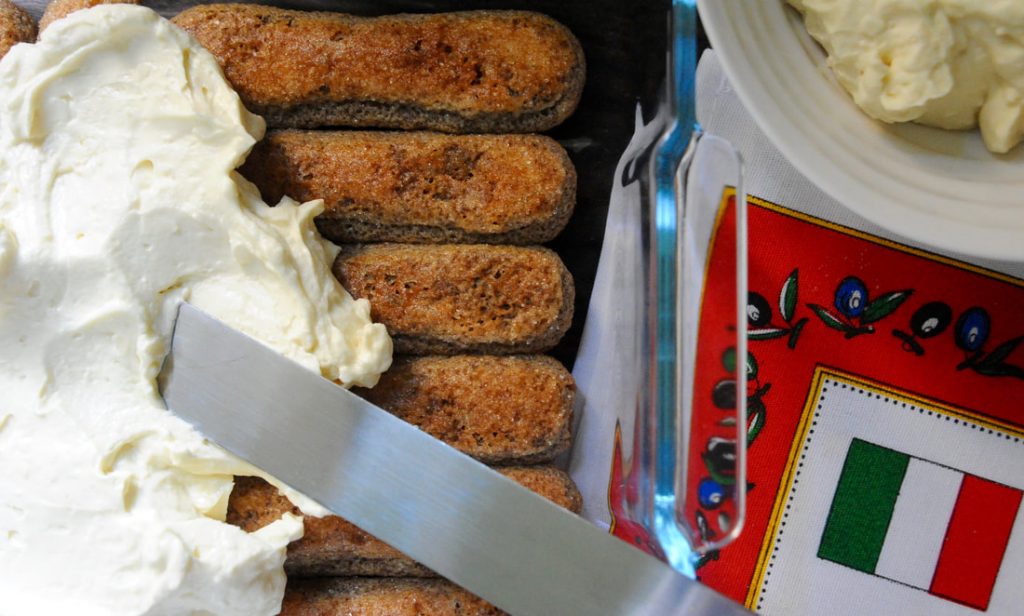
I must divulge, my preferred alcohol for this glorious dessert is in fact, one of Miss Windsor’s favourite tipples – Harvey’s Bristol Cream, which certainly adds a touch of festive flair! And before I forget, I livened up the creamy layer with a smattering of grated nutmeg, and before serving I decorated my creation with a flurry of snow-like almond flakes.
And by the way, this is my latest, rather overdue, mouth-watering addition to Mrs Simkins and Miss Windsor’s Italian Escapades – culinary collaboration.
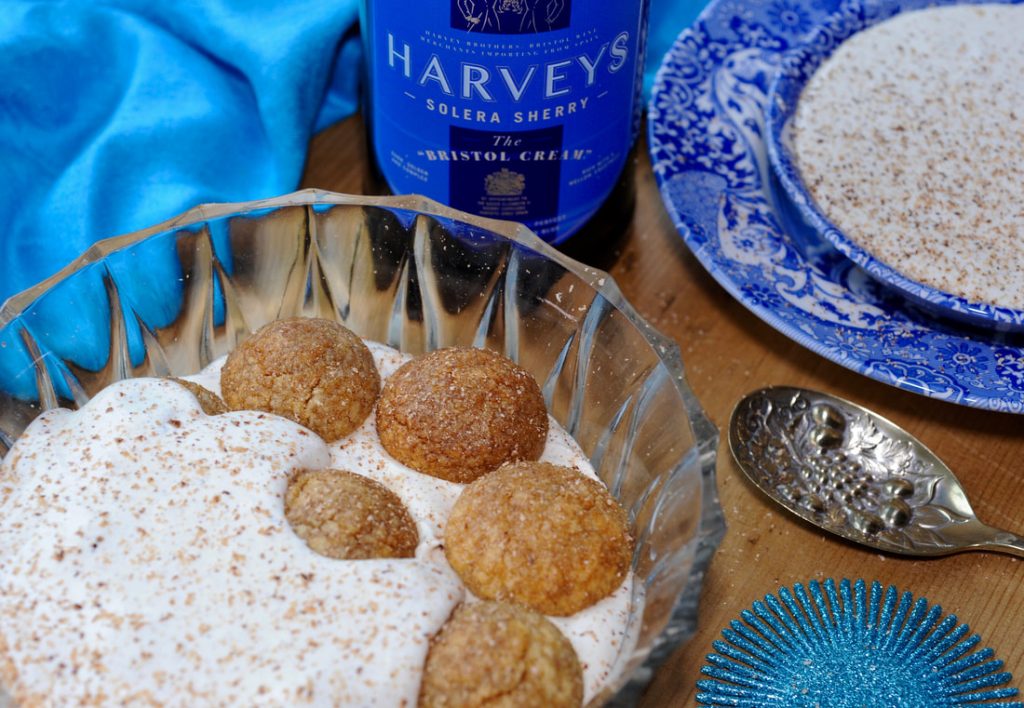
Darlings, I must tell you that during the grand ol’ year of 1882 Harvey’s Bristol Cream was created by John II & Edward Harvey. And for many years’ it was crafted from a blend of the finest wines imported from Jerez, Southern Spain and then bottled in Bristol City not too far from my childhood town of Backwell.
However, since the 1970’s Harvey’s Bristol Cream has been blended where Harvey’s vineyards are located – Jerez Southern Spain – such logical thinking, don’t ya think! And since the 1990s this exquisite sherry has been bottled in the illustrious Bristol Blue Glass – which is most pleasing to Miss Windsor, as it still holds a strong Bristolian connection.

Now, moving swiftly on, I’m excited to say I’m writing this with a bit of a festive spring in one’s step! Well, first off, here in the wilderness of South East London it’s 5 o’clock in the evening and a touch dark outside. Also, there’s only a week or so to go until Christmas, therefore, I feel a rather pleasant wintery/Christmassy chill in the air, which calls for a thick coat and gloves!
Oh, and I must recount, just a shy glimpse of a bottle of Harvey’s Bristol Cream evokes many fond memories of Christmas past spent with my beloved grandmother Josie, “Aaaah!” I hear you utter with sincere affection.

Darlings, although I’m a tad late sharing my creation following this year’s Italian summer getaway, in fact, I feel the timing couldn’t be more perfect, because in the Miss Windsor household Harvey’s Bristol Cream is only served during the festive season.
I say, I really do follow in Grandmother Josie’s footsteps, as she only served sherry in her finest crystal glasses during the cheerful month of December, which were always lovingly housed in her splendid, retro, g-plan, 1970s display cabinet – a grand affair, indeed!
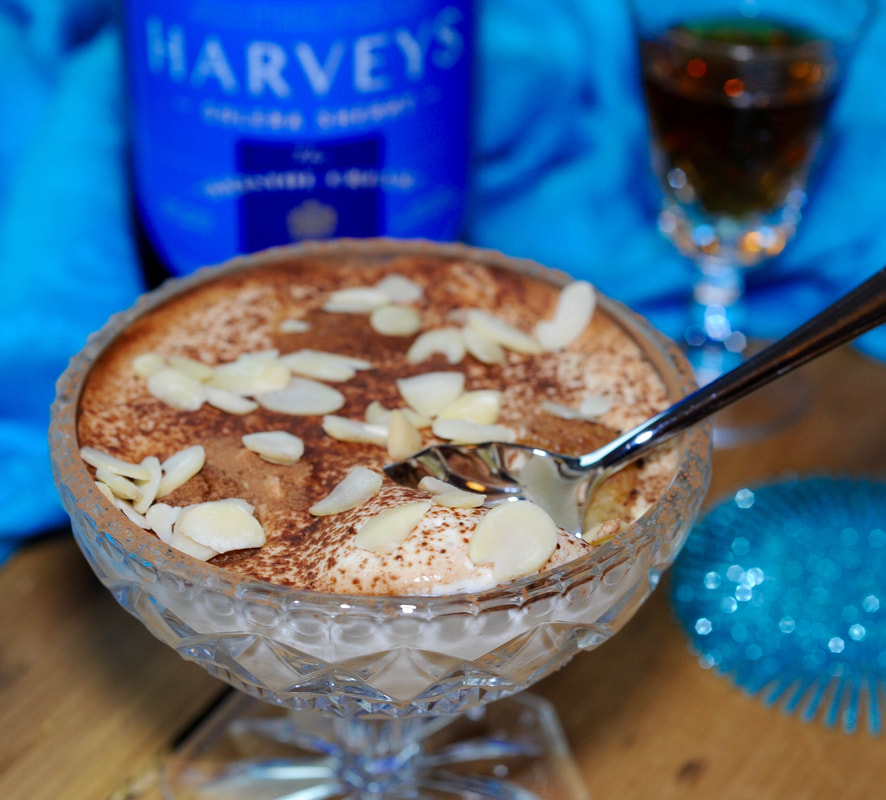
Now, did you know that the Italian translation for tiramisu is pull me up, pull it up, lift me up, or cheer me up? A little confused? so am I! Well, according to some sources, the devilishly sexy tiramisu was actually invented in the northern Italian town of Treviso and was not only served in restaurants but also to the clientele who frequented the local brothels (Oh, I say!).
On a more sobering note, this scrumptious Italian pud is also known as the Tuscan Trifle, and according to the jolly old internet the palate-pleasing tiramisu may have derived from a similar dessert which was created in Siena, Tuscany during the 17th century. However, and for some reason or another, it really took off in the 1960s/70s and is especially popular here in the UK.
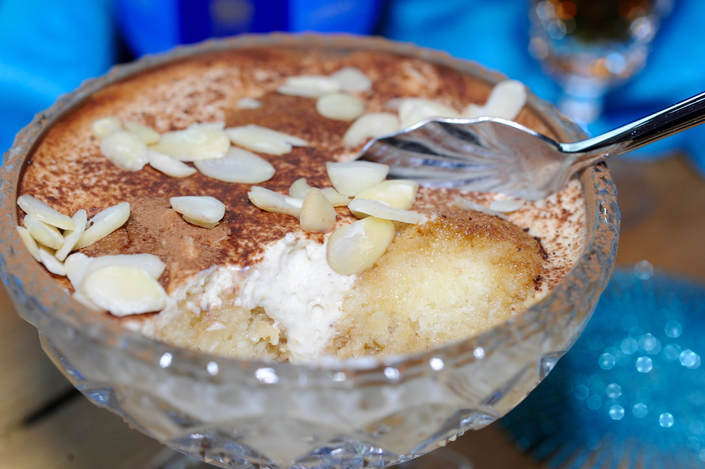
Darlings, before you toddle off to your kitchen, I must express my sheer disappointment regarding my culinary experience during a short jaunt to Pompeii! Well, my taste buds were not at all tickled by this classic Italian layered cake. Not only was my encounter a soggy one due to the unrelenting heat that affected the creamy layer, but I was also subjected to only a faint whiff of coffee; followed by the culinary crime of NO liquor!
So, following such a frightful ordeal, one dashed back to England and decided to create one’s very own version for the festive season – oozing with alcohol, of course, and generously flavoured with coffee.
Darlings, please run along now – toot sweet – and have a jolly good go at recreating my rather self-indulgent and exceedingly decadent Italian dessert – Miss Windsor’s Festive Sherry & Spice Tiramisu.
If you fancy whipping up something a bit more traditional for Christmas, why not recreate:
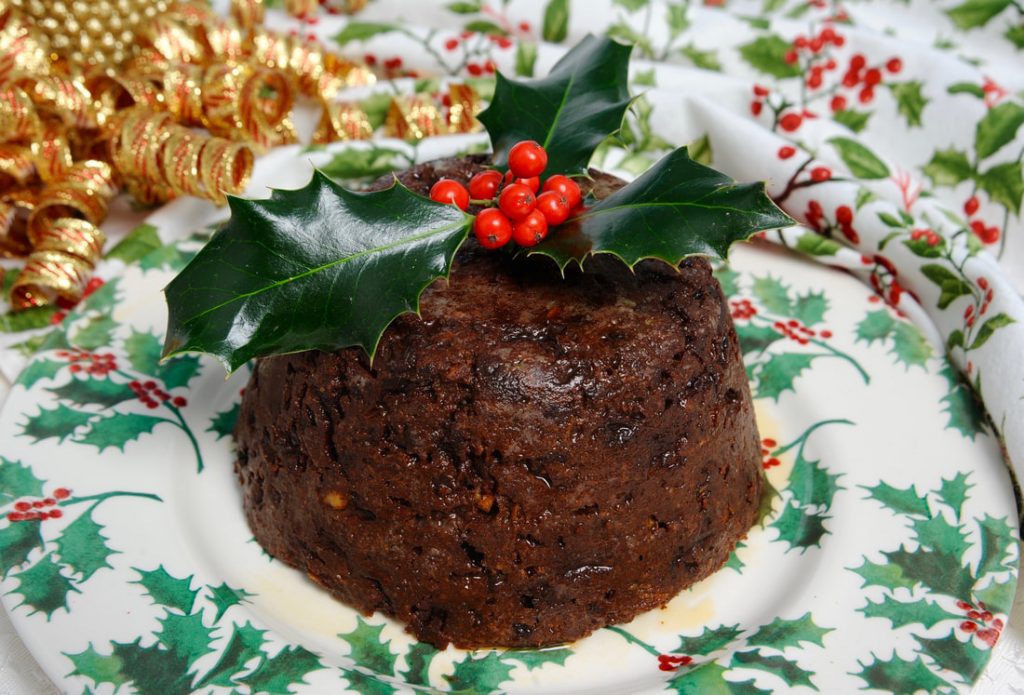
Miss Windsor x
ALL PHOTOGRAPHY BY MISS WINDSOR – EXCEPT PHOTO OF GRANDPA LARRY & GRANDMOTHER JOSIE!
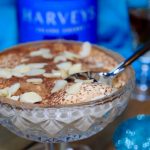
Miss Windsor’s Festive Sherry & Spice Tiramisu – with Harvey’s Bristol Cream!
Equipment
- Round glass, decorative bowl (9 cm / 7.5 inch) or square Pyrex dish (22 cm / 8.5 inch)
- Electric hand whisk
Ingredients
- 1 pack of Amaretto Morbido (Italian almond macaroons) or ladyfingers
- 4 heaped teaspoons of instant espresso coffee
- 150 ml (5 US fl oz) boiled water
- 200ml (7 US fl oz) any sherry (preferably Harvey’s Bristol Cream!)
- 2 eggs
- 70 g (just over 1/3 cup) golden caster sugar
- 500 g (2 cups) mascarpone cheese
- 1 & 1/2 nutmeg grated
- 3 teaspoons of cocoa powder
- generous handful of flaked almonds
Instructions
- First off, wash those grubby little mitts of yours – Ta very muchly!
- In a small bowl dissolve instant espresso coffee in boiling hot water. Leave to completely cool
- Now, mix the cooled coffee with approx. 2/3 of sherry and set to one side
- Separate the eggs – keep only one of the egg whites
- Whisk egg yolks with golden caster sugar until thick and pale. Fold in the mascarpone cheese and left-over sherry and give it a quick blast with the electric hand-whisk. Then gently fold in the grated nutmeg
- Using a separate bowl, whisk the egg white until it has thickened and appears rather bubbly
- Now, fold the egg white into the mascarpone mixture. Again, give it a quick blast with the electric hand-whisk. Put to one side
- Darlings line the bottom of your chosen dish with a layer of Italian almond macaroons or ladyfingers dipped into the coffee/sherry concoction. Make sure you soak both sides, just enough so they’re damp but not gooey!
- Spread half of the mascarpone mixture over the biscuits. Repeat with another layer of dampened Italian almond macaroons or ladyfingers. Then finish off with another creamy layer of the mascarpone mixture – How spiffing!
- Cover the dish with clingfilm and transfer to the cool environment of one’s refrigerator. Leave overnight, or a few hours will suffice!
- When you’re ready to serve your delicious festive Italian creation, then dust with cocoa powder and sprinkle with flaked almonds – voila!
- Darlings, please do enjoy with a drop or two of Harvey’s Bristol Cream, or sup away on any sherry you fancy
The post Festive Sherry & Spice Tiramisu – with Harvey’s Bristol Cream! appeared first on Miss Windsor's Delectables.
]]>The post Mrs Simkins Tiramisu Trifle! appeared first on Miss Windsor's Delectables.
]]>Two Tiramisu for You
Miss Windsor and I love tiramisu and have both noticed how actual Italian tiramisu in Italy isn’t terribly alcoholic, if at all.
We decided we’d bring you our own special versions, mine based on my Venice one and Miss Windsor’s made with one of her favourite tipples, Harvey’s Bristol Cream, which I think is an inspired British alternative to the customary Italian marsala or vin santo.
We love them both equally gorgeous and we hope you will too.

Mrs Simkins Tiramisu Trifle
Tiramisu is
one of the nicest puddings in the world but usually, to be honest, a bit
of a faff to make at home. As I mentioned above, I had the most lovely
one earlier this year during our late May jaunt to Venice, which on
close inspection, turned out to be more of a tiramisu trifle.
In
place of the expected marsala-enriched zabaglione blended with
mascarpone and layered with coffee-soaked sponge fingers, was a
beautiful confectioner’s custard sitting on coffee-soaked sponge, topped
off with whipped cream and cocoa powder. It was absolutely gorgeous.

I’d promised our tiramisu-loving friend I’d take a photo of a genuine Venetian tiramisu for her (she and her late husband visited Venice many times years ago and she always had tiramisu for pudding. They would sample different restaurants every night so she’s practically a world authority on Venetian tiramisu!)
Anyway, when my tiramisu arrived, it looked so inviting I dived straight in and only remembered the photo when I’d virtually licked the bowl clean.

Our friend came round for Sunday dinner recently and I made my own version of the Venice one for her. I couldn’t detect any alcohol in the original but since we all enjoy a tipsymisu I’ve added a generous measure of Kahlua coffee liqueur to the sponge.
A light dusting of drinking chocolate gives a more mellow finish than the traditional substantial amount of cocoa, but use cocoa, or grated dark chocolate, if you prefer.
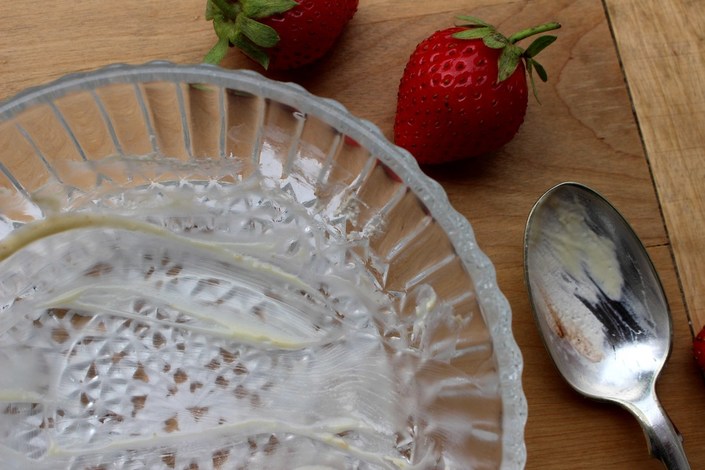
We all loved it and she said it was the best she’d ever tasted: certainly, she tucked into seconds very enthusiastically and we’ve promised to have it again next time she comes round.
Tiramisu literally translates from the Italian as ‘pick-me-up’ or ‘cheer me up; and this one certainly left us all feeling very perky and cheered up indeed!
Toodles!
Mrs Simkins x

Mrs Simkins Tiramisu Trifle!
Equipment
- A 20cm rectangular dish will accommodate 100g sponge fingers perfectly
Ingredients
Sponge layer
- Approximately half 200g pack Italian sponge fingers or savoiardi (aka ladyfingers)
- 150 ml strong brewed coffee
- 3 measures (45ml) Kahlua
Custard
- 2 egg yolks
- 1 egg
- ½ teaspoon vanilla extract
- 50 g golden caster sugar
- 175 ml milk
- 175 ml double cream
- 3 level tablespoons cornflour
Plus
- 300 ml double cream
- Drinking chocolate or cocoa powder to finish
Instructions
- Lay the sponge fingers in the dish and pour over coffee and liqueur. Chill.
- Whisk egg and yolks and pass through a sieve. Whisk sieved egg into a roomy bowl with vanilla and sugar until foaming.
- Mix cornflour to a smooth paste with 3-4 tablespoons of cold milk taken from the measured amount.
- Warm milk and cream in a small heavy bottomed pan until almost boiling.
- Pour into the cornflour paste, whisking gently throughout.
- Now whisk milk, cream and cornflour mixture gently into the combined eggs, sugar and vanilla.
- Wash out pan and return mixture to the heat. Cook gently, stirring gently constantly with a wooden spoon changing to a whisk as the mixture starts to thicken.
- Once thickening, turn off heat and whisk until smooth and creamy. Cool slightly and pour over sponge fingers. Chill for several hours until set.
- Whisk cream into soft peaks and spread over custard. Chill again and dust with drinking chocolate before serving.
- For complete perfection, serve with strawberries and a small coffee on the side.
The post Mrs Simkins Tiramisu Trifle! appeared first on Miss Windsor's Delectables.
]]>The post Miss Windsor’s Cinnamon Lime Jelly! appeared first on Miss Windsor's Delectables.
]]>Hello, darlings!
Following an unfortunate spell of blustery showers and cool evenings, one finds it hard to believe that we’re slap-bang in the middle of British “summertide”! However, during those occasional sunny moments, I craved to nourish my palate with a slightly piquant, a tad spicy, frightfully refreshing, and rather wobbly sweet treat.
Therefore, to satisfy one’s yearning, I recreated with the aid of my culinary talent, a recipe for plain old Lime Jelly that I stumbled upon in my 1935 edition of The Radiation Cookery Book – I’m pleased to present Miss Windsor’s Cinnamon Lime Jelly.

Darlings, Miss Windsor recommends that her “sub-Lime” dessert must be enjoyed with a handful of summer berries and a drop of single cream! Alternatively, why not take a quick jaunt down memory lane and devour your jelly portion with a huge dollop of vanilla ice cream – of course, served in a paper bowl and eaten with a plastic spoon!
In fact, jelly and ice cream was Grandmother Josie’s most favourite dessert of all time, even in her maturer years she favoured this more than anything. Actually, I do recall that she was rather partial to Chivers Jelly, blackcurrant was her preferred flavour.
Miss Windsor x
PHOTOGRAPHY BY MISS WINDSOR

Miss Windsor’s Cinnamon Lime Jelly!
Equipment
- Piece of muslin cloth or pillow case!
- Large jelly mould or selection of 6/8 small vessels
Ingredients
- Juice of 2 Limes
- Rind of 3 Limes
- 170 g (1 cup) granulated sugar
- 50 g (about 1/2 cup) Dr Oetker Gelatine – or any brand of your choice!
- 1 Litre (4 & 3/4 cups) of Water
- Small stick of cinnamon
- Additional 150ml (3/4 cups) lime juice
- Drop of green food colouring
Instructions
- First off, please ‘lather up’ your ‘mitts’ with a drop of soap, then rinse thoroughly!
- Being careful not to grate off a finger or two, remove the rind with your zest grater or another implement of choice!
- Using your lemon Squeezer, squeeze the juice from 2 limes
- Measure the amount of gelatine required
- Reach for your mixing bowl and soak the gelatine in the juice
- Measure the sugar, transfer to your saucepan, then add the water and rind. Simmer gently for 20 minutes – without the lid on
- To the saucepan stir in the gelatine and ‘additional’ lime juice. Please don’t follow Miss Windsor’s ‘example’ and neglect to add this vital ingredient, otherwise it will turn out rather bland!
- Add a drop of green food colouring and leave to completely cool (about 30 to 45 mins)
- Into your mixing bowl, strain the mixture through a muslin cloth. Or just like Miss Windsor, use a pillow case!
- Dampen your mould or vessels with water, then pour in the liquid – Why not festoon your creation with a strawberry or two!
- With a steady hand, place in the fridge to set
- When ready to serve, and for a few moments only, dip the jelly mould in hot water then turn out onto a decorative plate of your choice – or eat straight from an individual dish
- Enjoy this punchy, yet palate quenching dessert with a drizzle of single cream and a handful of berries!
The post Miss Windsor’s Cinnamon Lime Jelly! appeared first on Miss Windsor's Delectables.
]]>